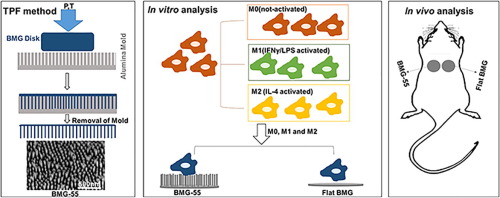Acta Biomaterialia ( IF 9.4 ) Pub Date : 2018-06-01 , DOI: 10.1016/j.actbio.2018.05.051 Mahdis Shayan 1 , Jagannath Padmanabhan 2 , Aaron H Morris 2 , Bettina Cheung 2 , Ryan Smith 2 , Jan Schroers 3 , Themis R Kyriakides 4

|
Polarization of macrophages by chemical, topographical and mechanical cues presents a robust strategy for designing immunomodulatory biomaterials. Here, we studied the ability of nanopatterned bulk metallic glasses (BMGs), a new class of metallic biomaterials, to modulate murine macrophage polarization. Cytokine/chemokine analysis of IL-4 or IFNγ/LPS-stimulated macrophages showed that the secretion of TNF-α, IL-1α, IL-12, CCL-2 and CXCL1 was significantly reduced after 24-hour culture on BMGs with 55nm nanorod arrays (BMG-55). Additionally, under these conditions, macrophages increased phagocytic potential and exhibited decreased cell area with multiple actin protrusions. These in vitro findings suggest that nanopatterning can modulate biochemical cues such as IFNγ/LPS. In vivo evaluation of the subcutaneous host response at 2 weeks demonstrated that the ratio of Arg-1 to iNOS increased in macrophages adjacent to BMG-55 implants, suggesting modulation of polarization. In addition, macrophage fusion and fibrous capsule thickness decreased and the number and size of blood vessels increased, which is consistent with changes in macrophage responses. Our study demonstrates that nanopatterning of BMG implants is a promising technique to selectively polarize macrophages to modulate the immune response, and also presents an effective tool to study mechanisms of macrophage polarization and function.
Statement of Significance
Implanted biomaterials elicit a complex series of tissue and cellular responses, termed the foreign body response (FBR), that can be influenced by the polarization state of macrophages. Surface topography can influence polarization, which is broadly characterized as either inflammatory or repair-like. The latter has been linked to improved outcomes of the FBR. However, the impact of topography on macrophage polarization is not fully understood, in part, due to a lack of high moduli biomaterials that can be reproducibly processed at the nanoscale. Here, we studied macrophage interactions with nanopatterned bulk metallic glasses (BMGs), a class of metallic alloys with amorphous microstructure and formability like polymers. We show that nanopatterned BMGs modulate macrophage polarization and transiently induce less fibrotic and more angiogenic responses. Overall, we demonstrate nanopatterning of BMG implants as a technique to polarize macrophages and modulate the FBR.
中文翻译:

纳米图案块状金属玻璃基生物材料调节巨噬细胞极化
化学、拓扑和机械信号引起的巨噬细胞极化为设计免疫调节生物材料提供了强有力的策略。在这里,我们研究了纳米图案块状金属玻璃(BMG)(一种新型金属生物材料)调节小鼠巨噬细胞极化的能力。IL-4或IFNγ/LPS刺激的巨噬细胞的细胞因子/趋化因子分析表明,在55nm纳米棒的BMG上培养24小时后,TNF-α、IL-1α、IL-12、CCL-2和CXCL1的分泌显着减少阵列(BMG-55)。此外,在这些条件下,巨噬细胞的吞噬潜力增加,并表现出细胞面积减少和多个肌动蛋白突起。这些体外研究结果表明纳米图案可以调节生化信号,例如 IFNγ/LPS。2 周时皮下宿主反应的体内评估表明,BMG-55 植入物附近的巨噬细胞中 Arg-1 与 iNOS 的比率增加,表明极化的调节。此外,巨噬细胞融合和纤维囊厚度减少,血管数量和大小增加,这与巨噬细胞反应的变化一致。我们的研究表明,BMG 植入物的纳米图案化是一种有前途的技术,可以选择性地极化巨噬细胞以调节免疫反应,并且还为研究巨噬细胞极化和功能的机制提供了有效的工具。
重要性声明
植入的生物材料引起一系列复杂的组织和细胞反应,称为异物反应(FBR),可能受到巨噬细胞极化状态的影响。表面形貌会影响极化,其大致特征为炎症性或修复性。后者与 FBR 结果的改善有关。然而,形貌对巨噬细胞极化的影响尚未完全了解,部分原因是缺乏可在纳米尺度上重复加工的高模量生物材料。在这里,我们研究了巨噬细胞与纳米图案块体金属玻璃(BMG)的相互作用,纳米块金属玻璃是一类具有非晶态微观结构和像聚合物一样可成形的金属合金。我们发现纳米图案 BMG 可调节巨噬细胞极化并短暂诱导较少的纤维化反应和更多的血管生成反应。总的来说,我们证明了 BMG 植入物的纳米图案化是一种极化巨噬细胞和调节 FBR 的技术。











































 京公网安备 11010802027423号
京公网安备 11010802027423号